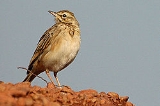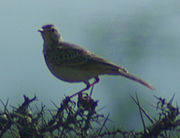
African Pipit
Encyclopedia
The African Pipit is a fairly small passerine
bird
belonging to the pipit
genus Anthus in the family Motacillidae
. It is also known as the Grassveld Pipit or Grassland Pipit. It was formerly lumped together with the Richard's
, Australasian
, Mountain
and Paddyfield Pipit
s in a single species, Richard's Pipit (Anthus novaeseelandiae), but is now often treated as a species in its own right.
, Central
and East
Africa
, south-east of a line from Angola
through the Democratic Republic of the Congo
to Sudan
. It is also found in south-western Arabia. There is an isolated population in the highlands of Cameroon
which is sometimes considered to be a separate species: Cameroon Pipit (Anthus camaroonensis).
 The African Pipit is 15 to 17 cm long and is a slender bird with an erect stance. It is buffy-brown above with darker streaks. The underparts are white or pale buff with a streaked breast and plain belly and flanks. The face is boldly patterned with a pale stripe over the eye and a dark malar stripe. The outer tail-feathers are white. The legs are long and pinkish and the slender bill
The African Pipit is 15 to 17 cm long and is a slender bird with an erect stance. It is buffy-brown above with darker streaks. The underparts are white or pale buff with a streaked breast and plain belly and flanks. The face is boldly patterned with a pale stripe over the eye and a dark malar stripe. The outer tail-feathers are white. The legs are long and pinkish and the slender bill
is dark with a yellowish base to the lower mandible. Juvenile
birds have a blotched breast, scalloping on the upperparts and some streaking on the flanks.
The song
is a repeated series of twittering notes, given during an undulating song-flight or from a low perch.
The Cameroon Pipit is slightly larger and darker with buff underparts.
has lumped
the African Pipit with Richard's Pipit, and therefore has given it no separate conservation status. However, Zimmerman, Turner, and Pearson (1999) call it "the common East African pipit."
Passerine
A passerine is a bird of the order Passeriformes, which includes more than half of all bird species. Sometimes known as perching birds or, less accurately, as songbirds, the passerines form one of the most diverse terrestrial vertebrate orders: with over 5,000 identified species, it has roughly...
bird
Bird
Birds are feathered, winged, bipedal, endothermic , egg-laying, vertebrate animals. Around 10,000 living species and 188 families makes them the most speciose class of tetrapod vertebrates. They inhabit ecosystems across the globe, from the Arctic to the Antarctic. Extant birds range in size from...
belonging to the pipit
Pipit
The pipits are a cosmopolitan genus, Anthus, of small passerine birds with medium to long tails. Along with the wagtails and longclaws, the pipits make up the family Motacillidae...
genus Anthus in the family Motacillidae
Motacillidae
The Motacillidae are a family of small passerine birds with medium to long tails. There are around 65 species in 6 genera and they include the wagtails, longclaws and pipits. The longclaws are entirely restricted to the Afrotropics, and the wagtails are predominately found in Europe, Africa and...
. It is also known as the Grassveld Pipit or Grassland Pipit. It was formerly lumped together with the Richard's
Richard's Pipit
The Richard's Pipit is a medium-sized passerine bird which breeds in open grasslands in northern Asia. It is a long-distance migrant moving to open lowlands in southern Asia. It is a rare but regular vagrant to western Europe...
, Australasian
Australasian Pipit
The Australasian Pipit is a fairly small passerine bird of open country in Australia, New Zealand and New Guinea. It belongs to the pipit genus Anthus in the family Motacillidae....
, Mountain
Mountain Pipit
The Mountain Pipit is a species of bird in the Motacillidae family.It is found in Lesotho, South Africa, possibly Botswana, possibly Democratic Republic of the Congo, possibly Namibia, and possibly Zambia....
and Paddyfield Pipit
Paddyfield Pipit
Paddyfield Pipit is a small passerine bird in the pipits and wagtail family. It is a resident breeder in open scrub, grassland and cultivation in southern Asia east to the Philippines. Although among the few breeding pipits in the Asian region, identification becomes difficult in winter when...
s in a single species, Richard's Pipit (Anthus novaeseelandiae), but is now often treated as a species in its own right.
Distribution and habitat
It occurs in grassland and fields in SouthernSouthern Africa
Southern Africa is the southernmost region of the African continent, variably defined by geography or geopolitics. Within the region are numerous territories, including the Republic of South Africa ; nowadays, the simpler term South Africa is generally reserved for the country in English.-UN...
, Central
Central Africa
Central Africa is a core region of the African continent which includes Burundi, the Central African Republic, Chad, the Democratic Republic of the Congo, and Rwanda....
and East
East Africa
East Africa or Eastern Africa is the easterly region of the African continent, variably defined by geography or geopolitics. In the UN scheme of geographic regions, 19 territories constitute Eastern Africa:...
Africa
Africa
Africa is the world's second largest and second most populous continent, after Asia. At about 30.2 million km² including adjacent islands, it covers 6% of the Earth's total surface area and 20.4% of the total land area...
, south-east of a line from Angola
Angola
Angola, officially the Republic of Angola , is a country in south-central Africa bordered by Namibia on the south, the Democratic Republic of the Congo on the north, and Zambia on the east; its west coast is on the Atlantic Ocean with Luanda as its capital city...
through the Democratic Republic of the Congo
Democratic Republic of the Congo
The Democratic Republic of the Congo is a state located in Central Africa. It is the second largest country in Africa by area and the eleventh largest in the world...
to Sudan
Sudan
Sudan , officially the Republic of the Sudan , is a country in North Africa, sometimes considered part of the Middle East politically. It is bordered by Egypt to the north, the Red Sea to the northeast, Eritrea and Ethiopia to the east, South Sudan to the south, the Central African Republic to the...
. It is also found in south-western Arabia. There is an isolated population in the highlands of Cameroon
Cameroon
Cameroon, officially the Republic of Cameroon , is a country in west Central Africa. It is bordered by Nigeria to the west; Chad to the northeast; the Central African Republic to the east; and Equatorial Guinea, Gabon, and the Republic of the Congo to the south. Cameroon's coastline lies on the...
which is sometimes considered to be a separate species: Cameroon Pipit (Anthus camaroonensis).
Description

Beak
The beak, bill or rostrum is an external anatomical structure of birds which is used for eating and for grooming, manipulating objects, killing prey, fighting, probing for food, courtship and feeding young...
is dark with a yellowish base to the lower mandible. Juvenile
Juvenile (organism)
A juvenile is an individual organism that has not yet reached its adult form, sexual maturity or size. Juveniles sometimes look very different from the adult form, particularly in terms of their colour...
birds have a blotched breast, scalloping on the upperparts and some streaking on the flanks.
The song
Bird song
Bird vocalization includes both bird calls and bird songs. In non-technical use, bird songs are the bird sounds that are melodious to the human ear. In ornithology and birding, songs are distinguished by function from calls.-Definition:The distinction between songs and calls is based upon...
is a repeated series of twittering notes, given during an undulating song-flight or from a low perch.
The Cameroon Pipit is slightly larger and darker with buff underparts.
Conservation status
BirdLife InternationalBirdLife International
BirdLife International is a global Partnership of conservation organisations that strives to conserve birds, their habitats and global biodiversity, working with people towards sustainability in the use of natural resources...
has lumped
Lumpers and splitters
Lumping and splitting refers to a well-known problem in any discipline which has to place individual examples into rigorously defined categories. The lumper/splitter problem occurs when there is the need to create classifications and assign examples to them, for example schools of literature,...
the African Pipit with Richard's Pipit, and therefore has given it no separate conservation status. However, Zimmerman, Turner, and Pearson (1999) call it "the common East African pipit."

